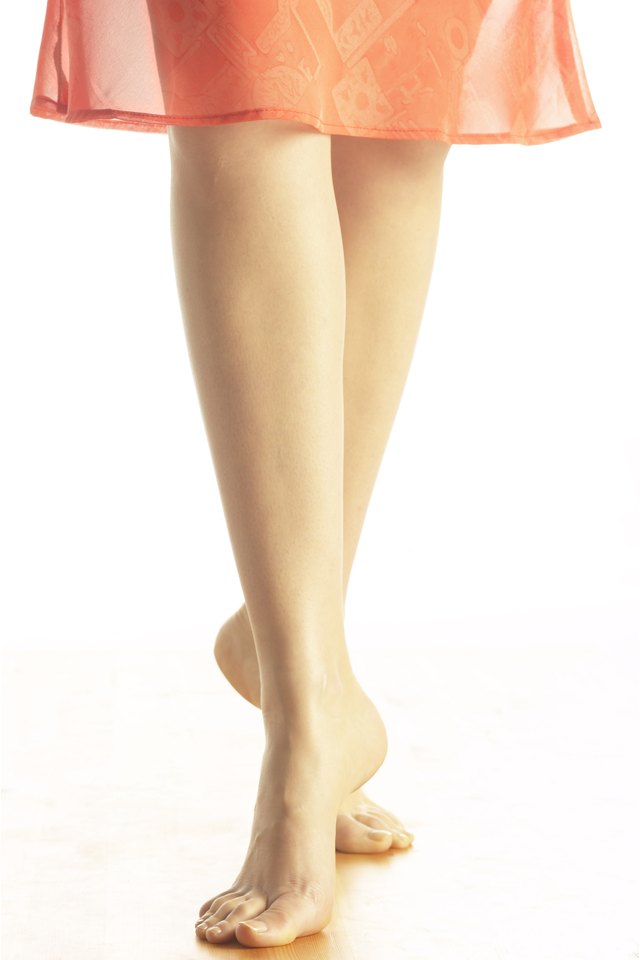Benefits of Tiptoe Walking for Adults

Rising onto your toes involves significant plantar flexion, or movement of your foot away from your shin. Plantar flexing the foot forces your calf muscles to contract, which explains why calf raises feature so prominently in lower-leg strength routines. If standard calf raises are becoming old hat or if you want to add more movement to your calf-building equation, try tiptoe walking. Walking on your toes offers an impressive set of benefits, particularly as you age.
Boosting Calf Strength
As an adult, you face the prospect of age-related loss of muscle mass and strength, or sarcopenia. A typical 30-year-old can expect to lose roughly 25% of his muscle mass and strength over the next 40 years, according to Harvard Health Publications. Resistance training -- including simple bodyweight exercises -- combats the natural aging process by building muscle and boosting strength. Using your own body weight for resistance, tiptoe walking fires up your calf muscles, including the superficial, heart-shaped gastrocnemius and its assistant, the deeper-lying soleus. Bigger, stronger calves translates into a more shapely lower leg, better ankle stability and increased power. Toe walking is also a functional exercise, meaning it trains your muscles to work together to perform sport-specific or everyday tasks. Simply put, toe walking builds strength in a way that benefits your athletic performance now and preserves your ability to function down the road.
Prodding Your Proprioceptors
Tiptoe walking can improve your proprioception, or your sense of where particular body parts are in space. Skills you developed when you were younger -- including balance, agility and coordination -- depend on good proprioception. These skills can wane with age if you if you don't make an effort to maintain them. To develop or maintain your proprioceptive ability, you can use tools specially designed for this purpose -- such as balance boards -- or you can perform simple exercises, including one-legged balancing, walking on uneven surfaces and tiptoe walking. To increase the proprioceptive challenge of toe walking, try walking with your eyes closed or balancing briefly on one leg mid-stride.
Maintaining Your Independence
Harvard Health Publications reports that by age 65, more than one in three people suffers from a fall. By boosting calf strength, improving your balance and stability and increasing your agility and coordination -- all by-products of tiptoe walking -- you reduce your susceptibility to age-related falls. Such falls can result in debilitation and partial or total loss of independence. Making tiptoe walking part of a more extensive resistance training program can help you avoid age-related injures and maintain your independence.
Regression and Progression
If you feel unsteady when walking on tiptoe, take balance and movement out of the equation. Instead, do standing calf raises -- lifting and lowering your heels -- while gripping the edge of a countertop or the back of a chair for light support. If you've mastered basic toe walking, you can vary or add intensity to the exercise. Walk with your legs rotated inward or outward at the hips to target different muscle fibers in the calf. Up the intensity by increasing the duration of every set. Start with three or four sets of 15 seconds of walking, resting for 20 seconds between sets. When that becomes too easy, bump it up to 60 seconds of walking per set or walk holding a dumbbell in each hand.
Reminders
Precede tiptoe walking with a brief warm-up. Walk, jog or march in place for five minutes to raise your core body temperature and increase circulation to your lower body. Follow with a lower-leg dynamic stretch -- such as ankle circles -- to further prepare your calves and ankles for action. When you walk on your toes, maintain good posture -- keep your head centered over your spine, your back straight and your shoulders down and slightly back -- and breathe evenly. Maintain total control of your movement and stop if you feel unsteady. Follow the exercise with a light calf stretch, holding the stretch position for up to 30 seconds on each leg, to prevent soreness and maintain flexibility. If you've injured your calf, ankle or foot in the past, speak to your doctor, physical therapist or personal trainer about the advisability of specific exercises.
References
Writer Bio
Judy Fisk has been writing professionally since 2011, specializing in fitness, recreation, culture and the arts. A certified fitness instructor with decades of dance training, she has taught older adults, teens and kids. She has written educational and fundraising material for several non-profit organizations and her work has appeared in numerous major online publications. Fisk holds a Bachelor of Arts in public and international affairs from Princeton University.
